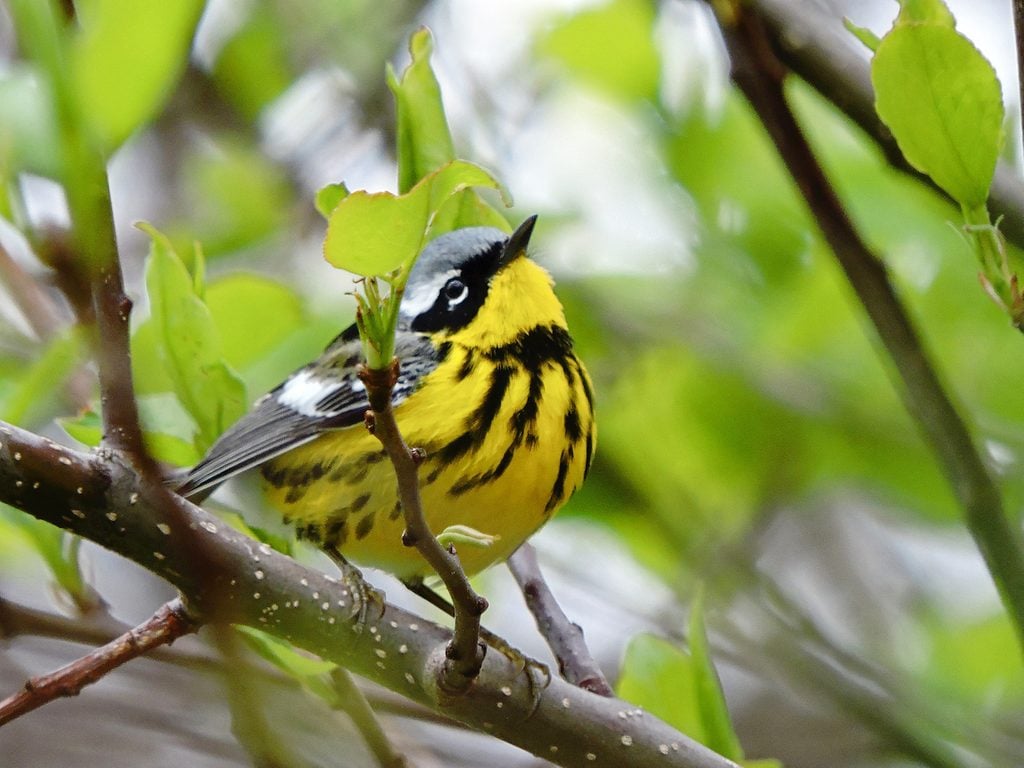Meet the Majestic Magnolia Warbler
Updated: May 13, 2024
Look for the brilliantly colored magnolia warbler in trees and shrubs during spring migration. Learn about their nests, range and more.

To put it simply–magnolia warblers are just plain cute.
These small, sweet borbs are worthy of adding to your life list on looks alone, though there’s a lot more to these captivating creatures. They’re elusive little ones, which means you’ll want to be strategic when attempting to spot one in the wild.
“They are a great little species, and they are certainly very enigmatic,” said Stacy Hill, an animal keeper in the Bird House at the Smithsonian’s National Zoo & Conservation Biology Institute. “They are always busy in the canopy–and they are really a special bird.”
On This Page
What Does a Magnolia Warbler Look Like?

“The magnolia warbler is quite small, with a very notable small, pointy beak. Its primary colors are grey, black and yellow,” said Stacy.
When considering color alone, this small songbird is often confused for Kirtland’s warbler or Canada warbler. And it’s even more confusing as their ranges overlap at times.
The easiest distinguishing feature from other black-and-yellow warblers is its white accents–especially those on its wings and long tail.
“It’s very notable in flight,” said Stacy. Males have striking white accents and a black mask that streaks across its neck and chest. Some birders describe the black markings as looking like a necklace. Females are more muted–mostly grey with smaller white wingbars.
Why Is the Bird Called a Magnolia Warbler?
Ornithologist Alexander Wilson, traveling west of the Appalachians in 1810, noticed this bird among magnolia trees in Mississippi. He called it the black-and-yellow warbler, but scientists later honored his observation by changing the name to magnolia warbler.
“It is a great lovely name,” said Stacy, “but not indicative of what it likes to use for most of its habitat. For a common name it has stuck.”
Magnolia Warbler Habitat and Range

This creature is here and gone quickly.
It only passes through the eastern half of the U.S. on its way from Central America and the Caribbean up to its breeding grounds in Canada–and vice versa. This means we have a narrow window for observation. Spring migration happens mainly in April and May. And the fall migration is mostly from late August to late October.
Your best chance to catch a glimpse of one is during migration. The magnolia is one of the more numerous warblers, and it flits around in the open, not hiding in dense cover like some other warblers.
Magnolia Warbler Nesting Habits
Those who live up north may discover a breeding pair in the Northeast or near the Great Lakes. They primarily breed in Canada’s dense coniferous, boreal forests of pine and spruce.
Male magnolia warblers arrive in breeding grounds at about the same time as their competitors, and work to establish their territories. To find a mate, he shakes his tail feathers.
“She may return that display,” said Stacy.
Once mated, the pair prepares a cup nest among dense evergreens with loosely-constructed grasses, weeds stalks and twigs lined with horsehair fungus. According to the Smithsonian, female magnolia warblers typically lay three to five eggs per clutch. The eggs are white with multicolored speckles.
Magnolia Warblers Songs and Calls

“[Females don’t] necessarily sing,” said Stacy. “There is not a lot of recorded female song in this species.”
What happens after is a mystery. We know the male approaches the female and courts her with his song and dance, though research can still be done to expand upon our knowledge of their courtship behaviors. As its conservation status is of least concern, research dollars are limited.
We do know that males have two notable song types–one for territory defense and another communicating with a female.
Bird sounds courtesy of The Cornell Lab of Ornithology
What Do Magnolia Warblers Eat?
Your best bet to spot this songbird is by hiking through your local woods during its migration timeframe. It’s an insect-eater and rarely visits backyards. In spring and summer, they rely heavily on caterpillars and larvae.
To entice one to your backyard, “provide a lot of native plant species and limit your use of pesticides,” says Stacy.
Draw them in by planting native trees and shrubs to attract the insects and larvae they eat. The songbird occasionally eats fruit or nectar.
Does the Magnolia Warbler Face Any Threats?

Light pollution disorients many birds, including magnolia warblers, and can cause collisions. “They use stars, the moon and sometimes the earth’s magnetic fields to travel,” said Stacy.
Organizations including the National Audubon Society tout the “Lights Out” program, encouraging people to turn off their outdoor lights at night during peak migration periods.
About the Expert
Stacy Hill is an animal keeper in the Bird House at the Smithsonian’s National Zoo & Conservation Biology Institute. The zoo cares for nearly 80 species of birds in its aviaries, including a breeding pair of magnolia warblers.
Sources
- All About Birds – magnolia warbler
- National Audubon Society – magnolia warbler
- Smithsonian National Zoo & Conservation Biology Institute
Why Trust Us?
For nearly 30 years, Birds & Blooms, a Trusted Media Brand, has been inspiring readers to have a lifelong love of birding, gardening and nature. We are the #1 bird and garden magazine in North America and a trusted online resource for over 15 million outdoor enthusiasts annually. Our library of thousands of informative articles and how-tos has been written by trusted journalists and fact-checked by bird and garden experts for accuracy. In addition to our staff of experienced gardeners and bird-watchers, we hire individuals who have years of education and hands-on experience with birding, bird feeding, gardening, butterflies, bugs and more. Learn more about Birds & Blooms, our field editor program, and our submission guidelines.

